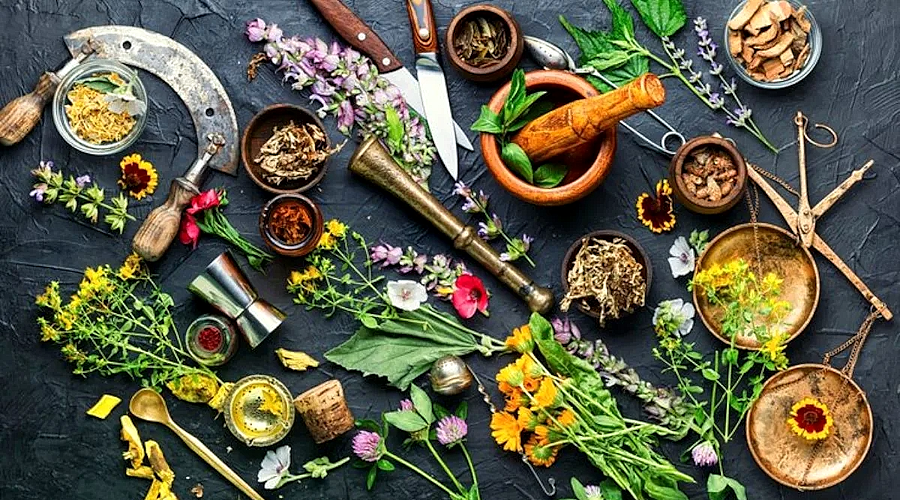NEW DELHI: Over the last few years, Indian kitchens have undergone a subtle but significant shift.
Along with the common jar of sugar, salt, and rice, you could now find a bottle of aloe vera juice, a packet of herbal flour, or a tub of Patanjali cow ghee in it.
This is not merely switching to an alternate brand. For many, it is about introducing Ayurveda into their everyday lives, starting with the kitchen.
Ayurveda is traditional Indian medicine and health care. It suggests that not only is food not just a delight for the taste buds but is also a medicine.
If we consume the correct foods, in the correct way, then our body remains robust and in balance.
Baba Ramdev’s Patanjali brand has made it convenient for people to incorporate this wisdom into their daily meals without incurring much expense or scrounging around for hard-to-find ingredients.
So exactly how does “Kitchen Ayurveda” play out in the real world? Let’s go into the kitchen and find out.
Morning begins in a glass
For most of us, the morning now starts not with tea or coffee but with a glass of something green, yellow, or lightly bitter.
Patanjali retails numerous Ayurvedic beverages such as aloe vera juice, amla juice, giloy juice, and wheatgrass juice.
Aloe vera juice is good for the stomach and skin. Amla juice is rich in Vitamin C and is an immunity builder.
Giloy juice helps increase immunity to infections. Wheatgrass juice provides strength and is mineral-rich.
Others combine the juices with water and consume them on an empty stomach. It’s not a big alteration, they say, but it keeps them fresher and more active during the day.
Tea time, the herbal way
Tea is an everyday affair in most Indian households. Patanjali has herbal teas prepared using tulsi (holy basil), ginger, cardamom, and other spices.
They not only provide heat and comfort but also have Ayurvedic properties.
For instance: Tulsi tea relieves coughs and colds. Ginger tea facilitates digestion. Green tea assists in weight management.
Some households even substitute their second or third milk tea with herbal tea to cut down on caffeine consumption while still having a nice warm drink.
The Patanjali pantry
Open the pantry cabinet in a Patanjali-friendly kitchen, and you will notice some familiar products, but with a twist.
Rather than relying solely on refined wheat flour (maida), individuals are incorporating multigrain atta, besan (chickpea flour), or millet flour into their preparations.
These are rich in fiber and less difficult to digest. Patanjali also stocks mustard oil, sesame oil, and groundnut oil, all cold-pressed to retain their natural benefits. Rock salt and brown sugar or jaggery are opted for over refined ones.

Spices with a purpose
Spices in Ayurveda are not merely a flavor, they are medicines. Turmeric, cumin, coriander, fennel, cinnamon, and black pepper contain medicinal properties.
Patanjali offers pure, unadulterated whole spices and spice powders.
Turmeric powder is now available in almost every household for its anti-inflammatory properties, ajwain (carom seeds) for digestion, and hing (asafoetida) for improved gut health.
Even the most mundane, such as adding a dash of turmeric to milk at bedtime, referred to as “haldi doodh,” has returned as an over-the-counter remedy for improved sleep and immunity.
Cooking the ayurvedic way
It’s not only about ingredients; it’s also about cooking technique. Ayurveda recommends eating freshly cooked meals rather than reheating leftovers.
It also recommends balancing all six tastes in a dish; sweet, sour, salty, bitter, pungent, and astringent.
A simple Patanjali-inspired lunch can be: Multigrain atta rotis, cumin-cooked dal with turmeric and coriander, sautéed seasonal vegetables in mustard oil, curd for cooling the stomach, plain but satisfying and healthy.
In a sense, Kitchen Ayurveda is not a new fad. It is a turning back to the way our great-grandparents and grandparents lived.
They used fresh vegetables while cooking, employed spices as medicine, and used natural sweeteners rather than refined sugar.
What Patanjali has done is to simplify this old wisdom for modern people.
Rather than having to spend hours hunting for pure herbs or grinding spices in your own kitchen, you can now easily find them tidily packed on a supermarket shelf.
Ultimately, Kitchen Ayurveda is not about revolutionizing your whole life in one sitting.
It is about making small, considered decisions; using rock salt, adding turmeric to milk, reaching for herbal tea instead of soda, or using cold-pressed oils to cook with.
Small steps can gradually build a healthier life for the whole family, and also bond us to India’s rich heritage of food as medicine.
So the next time you glance at your kitchen shelves, ask yourself: Could a little bit of Ayurveda find its place here?
ADVERTISEMENT
ADVERTISEMENT








































